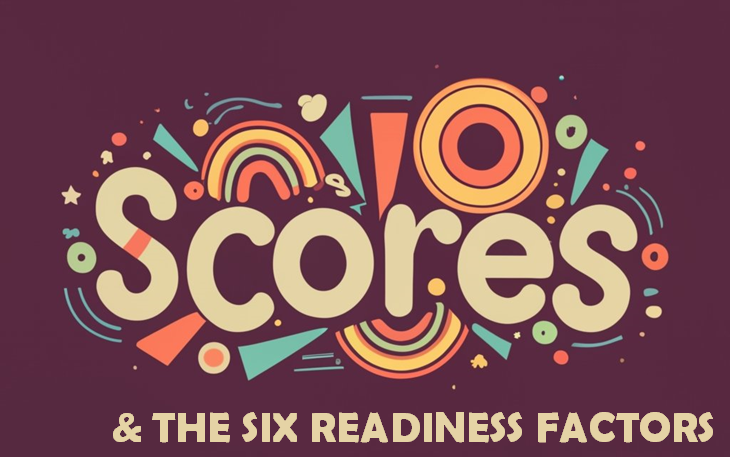Embarking on the journey to Enterprise Agility requires careful evaluation of your organization's current state.

By examining key readiness factors, you can determine how well-positioned your company is to undertake this transformation. One effective approach is to rate each factor on a scale, though the specific scale used can vary depending on the context and discretion of the consultant. Here is one example scale:
Scale:
1 - Not ready at all
2 - Somewhat ready but significant investment needed
3 - Moderately ready but gaps exist
4 - Mostly ready with a few enhancements needed
5 - Fully ready to adopt Enterprise Agility
The specifics of the scale can be adjusted as seen fit by the consultant assessing the organization's readiness. While the 1-5 scale here is provided as an illustration, consultants may choose to use a 1-10 scale, descriptive ranges like "poor, fair, good, excellent", colors like red, yellow, green, or any other scaled system that aligns with their approach. The most important factor is applying a consistent rating system to all readiness areas. Let's explore what assessing each readiness factor could look like using a sample scale as a starting point:
Industry Dynamics
Rate your industry's pace of change, disruptiveness, and unpredictability.
- Very slow, linear, predictable change
- Occasional disruptions but largely stable
- Moderate pace with some emerging competitors
- Rapid evolution with new entrants disrupting business models
- Extremely fast development of new technologies and competitors
A score of 4 or 5 indicates your industry could benefit greatly from Enterprise Agility to keep pace. A lower score suggests incremental improvements may be sufficient for now.
Company Culture
Consider how open and receptive your culture is to change and innovation.
- Very risk averse, resistant to change, and poor communication
- Willing to make minor tweaks but avoid bold moves
- Accepts change at moderate pace
- Encourages experimentation and quickly adopts successful changes
- Thrives on innovation with decentralized decision-making and great communication
If your culture leans toward categories 1 or 2, significant cultural transformation would be needed before pursuing Enterprise Agility. Scores of 4 or 5 reflect a culture poised for flexibility and resilience.
Organizational Structures
Assess how flexible and responsive your organizational structures are.
- Rigid siloed departments with high number of processes
- Some cross-department collaboration
- Moving toward matrix structure with some self-direction
- Adaptable structures in place and power decentralized
- Dynamic networks and teams with flexibility to reconfigure processes (Collective Capabilities)
Highly rigid and siloed organizations (1-2) would need a structural overhaul for greater agility. More adaptive systems with cross-linking (3-5) have better foundations.
Market Sensing Capabilities
Gauge your ability to rapidly sense and respond to market shifts.
- Minimal formal sensing process in place
- Occasional market research conducted
- Regular sensing through surveys and monitoring trends
- Frequent sensing integrated into operations at all levels using AI and other tech.
- Real-time market intelligence driving responsive innovation using AI and other tech.
Strong, proactive sensing capabilities (4-5) enable quick adaptation, while minimal sensing (1-2) leaves blindspots.
Customer Expectations
Evaluate your ability to meet rising customer expectations.
- Minimal direct customer feedback gathered
- Some voice-of-customer data collected
- Regular customer input to guide improvements
- Continuous customer engagement and co-creation
- Deep customer insights and co-creation to fuel constant personalized innovation
The higher your rating here, the better positioned you are to leverage Enterprise Agility to exceed customer expectations.
Leadership Commitment
Assess the willingness of leadership to champion new ways to deal with high uncertainty and accelerated change.
- Leaders avoid change and reinforce the status quo
- Leaders allow modest adjustments but resist big changes
- Leaders open to new approaches if persuasive evidence exists
- Leaders actively advocate for building resilience and dealing with accelerated change
- Leaders willing to make dramatic changes to deal with uncertainty and accelerated change
Securing full leadership commitment to enterprise agility is vital before proceeding. Low scores (1-2) imply substantial alignment work needed first.
By completing this assessment, you can identify readiness gaps and areas requiring investment if you decide to pursue high flexibility, resilience, and sustainability (Enterprise Agility). This analysis also highlights strengths you can leverage in your transformation. Evaluating your organization's preparedness in this structured way provides valuable insights to inform your strategy going forward.
